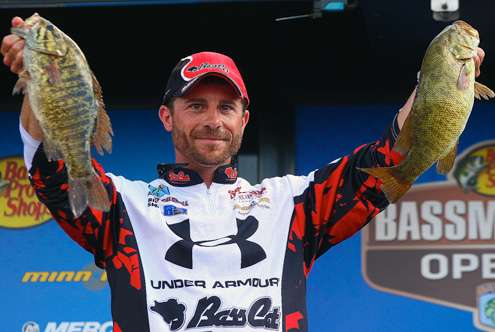
SYRACUSE, N.Y. — When a lake fishes “small” it means there’s not enough water to go around for the competition field. Translated in tournament lingo that means tough times ahead. It’s what anglers fishing Oneida Lake encountered at the Bass Pro Shops Northern Open #2.
Oneida spreads across 80 square miles. That’s not much water to go around for 160 boats filled with pairs of highly skilled anglers.
By virtue of the season Oneida fished even smaller than usual. The smallmouth and largemouth were tightly schooled near offshore structure. There was little hiding of choice spots on the oval-shaped lake. The open view exposed anyone on fish of any quality. Luck of the draw in the daily order of start meant getting on fish first. Everyone else was left with the spoils.
None of the above handicaps worried Jayme Caldwell. He’d never even been to Oneida Lake before tournament week. Yet the North Carolina pro arrived with a strategy downloaded to his brain and the hardware on his boat.
The mental and virtual memory paid off with a 4th-place finish and total weight of 48 pounds, 1 ounce. It came through a combination of the most unlikely of strategies. Those were Internet research and on-the-job training.
Caldwell is a sergeant major of the Army. Reading and interpreting sensitive radar and geographic data is part of his daily job. He’s assigned to a special operations unit at Fort Bragg, N.C. He’s also a skilled bass fisherman.
The sum of those skills equates to a mind capable of reading unfamiliar water through satellite imagery. Then applying that data in a real-time bass fishing situation. And that’s exactly what he did before and during the tournament.
Here’s how the online pattern came together. Caldwell researched previous tournaments on Oneida, paying special attention to keywords resonating with winning seasonal patterns. That information filed away, he switched to the core of the pattern.
Go into Caldwell’s home office and you’ll find an array of wide-screen monitors linked to a laptop computer. The computer and its screens bring the tournament water to him.
“I’m able to bring up on all three screens different topographic maps and satellite imagery,” he said. “There are subtle things I know what to look for and then try out when I practice.”
Caldwell uses a dizzying array of software and computer applications. Those include charts from LakeMaster and Navionics. He’s bookmarked the mapping sites for Google Earth and Bird’s Eye from Bing. He’s a fishidy.com social site junkie.
During any one time he might have any combination of the above displayed on the monitors.
“Using different satellite servers gives you different views,” he explained. “What I learned in the military is there’s more than one time of year when a satellite or an over flight takes imagery of an area.”
“There are times when I’ll end up with five different views of the same location,” he continued. “That’s great in a fishing situation. One shot may have been taken when the lake was 20 feet low.”
Other shots may have been taken 20 years ago. They can expose manmade and natural features missed in later mapping surveys.
One miss was a particularly big find for Caldwell at Oneida Lake. His meticulous online historical map study revealed a shoal not appearing on the modern maps.
He surveyed the rogue shoal in practice using the sonar’s side-imaging feature. It showed great potential.
“It held a lot of chunk rock and that’s prime smallmouth habitat,” he said.
Caldwell put the shoal to the test. It passed after he landed three solid smallmouth in successive casts.
Best part of all? It wasn’t on the map, at least for everyone else but Caldwell.
Things get technical at the helm of Caldwell’s boat. You’ll find two Humminbird 1198c SI Combo units. Those feature external GPS and side imaging sonar. Both features are displayed in full screen mode on the separate units. Next to them is an iPad used for displaying weather and even more maps.
Caldwell punched in the data to replicate the topographical features of the shoal into the array electronics onboard his boat. The results produced a replication of the shoal in other areas.
There were twelve of them in all. Key elements were chunk rock and a depth range of 14-18 feet. The secret shoal was number one on the list. The others would be needed to sustain a solid rate of limits during the tournament. The resulting milk run produced early, including a limit on the final day by 6:30 a.m.
“The lake did fish small, but not for me,” he said.
That makes small a relative term when you do your homework, even when it’s at home before you’ve never seen the lake.

